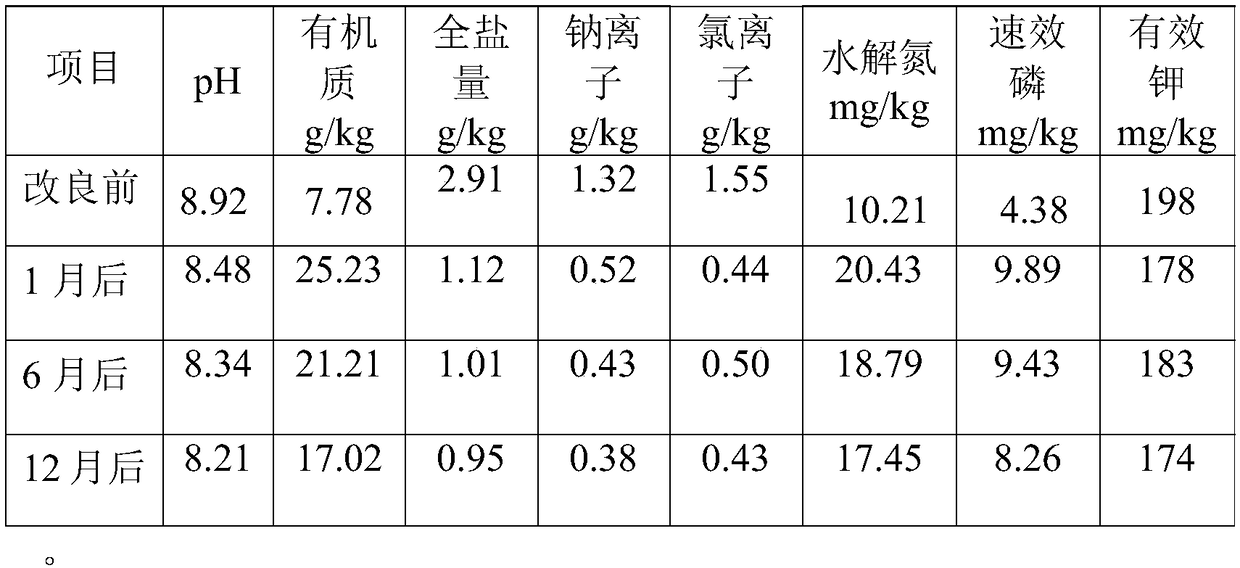Method for disposing green plant wastes by classification for constructing saline-alkali soil body
A technology of plant waste and saline-alkali land, which is applied in the field of urban solid waste disposal and saline-alkali soil improvement, can solve the problem of high cost, achieve low raw material cost, improve the quality of urban ecological environment, and be easy to operate
- Summary
- Abstract
- Description
- Claims
- Application Information
AI Technical Summary
Problems solved by technology
Method used
Image
Examples
Embodiment 1
[0024] In a coastal area near the coast, a new city land was formed by artificial mud blowing. According to the construction needs, the land was greened. The area near the seawall has been planted with rows of poplar shelter forests for more than 30 years. Produces copious amounts of litter.
[0025] Step 1: Conduct on-the-spot investigation on saline-alkali land. The soil characteristics of saline-alkali land are: pH=8.7±0.23, salt content=0.32±0.078%, organic matter=7.82±0.23mg / kg, Na+=1.46g / kg, Cl-=1.74 g / kg, the texture is silt clay, and the normal underground water level is about 120cm, which belongs to medium saline soil.
[0026] Step 2: Use poplar pruning in the shelter forest, typhoon or naturally occurring litter for local utilization, and classify and dispose according to the size of poplar branches. Cut the large-diameter branches into 20-30cm per section with a saw, and smolder in a spontaneously ignited dark fire for 1 hour (at 250° C.) in an oxygen-deficient st...
Embodiment 2
[0033] Plants grown in a certain saline-alkali land generally do not grow well, and some plants even die, so the saline-alkali land needs to be improved.
[0034] Step 1: On-site survey: Considering that the plants have been planted, it is difficult to carry out a comprehensive transformation. Local improvements will be made in combination with different products of greening plant waste.
[0035] Step 2: Find a green plant waste disposal site near the saline-alkali land, and modify and improve the processing of different types of green plant waste. Wherein the large-diameter branch is cut into every section 20~30cm with a saw, and smolders with a simple and easy carbonization furnace under a state of oxygen deficiency in a spontaneously ignited dark fire for 1 hour (at 250° C.) to develop the initial product of biochar; the diameter is slightly smaller ( 3-5cm) and leaves-free branches are crushed into wood chips with a particle size greater than 2cm and a thickness of about 0...
Embodiment 3
[0042] Plants grown in a certain saline-alkali land generally do not grow well, and some plants even die. It is necessary to improve the saline-alkali land. The specific methods are as follows:
[0043] Step A, classified disposal of greening plant waste
[0044] Step 1: First, simply classify the green plant waste entering the disposal site, and then classify and dispose of different types of green plant waste;
[0045] The second step: the development of the initial biochar product: pick out the large branches, remove the redundant thin branches and leaves, and cut the branches with a diameter of more than 5cm into 30cm sections with a saw; in order to reduce costs, build a simple carbonization furnace. Carry out spontaneous smoldering in dark fire for 1 hour (at 250°C) under the condition of hypoxia; cool down for standby;
[0046] Step 3: Select branches with a diameter of 2 to 5 cm, remove excess twigs and leaves, use a slicer to crush the branches into wood chips or sti...
PUM
 Login to View More
Login to View More Abstract
Description
Claims
Application Information
 Login to View More
Login to View More - Generate Ideas
- Intellectual Property
- Life Sciences
- Materials
- Tech Scout
- Unparalleled Data Quality
- Higher Quality Content
- 60% Fewer Hallucinations
Browse by: Latest US Patents, China's latest patents, Technical Efficacy Thesaurus, Application Domain, Technology Topic, Popular Technical Reports.
© 2025 PatSnap. All rights reserved.Legal|Privacy policy|Modern Slavery Act Transparency Statement|Sitemap|About US| Contact US: help@patsnap.com



